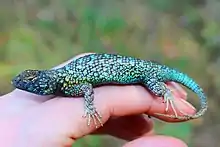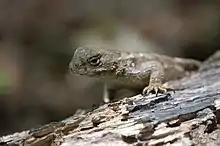Western fence lizard
The western fence lizard (Sceloporus occidentalis) is a common lizard of Arizona, New Mexico, California, Idaho, Nevada, Oregon, Utah, Washington, Northern Mexico, and the surrounding area. As the ventral abdomen of an adult is characteristically blue, it is also known as the blue-belly.
| Western fence lizards | |
|---|---|
 | |
| A western fence lizard in Sacramento County, California | |
| Scientific classification | |
| Domain: | Eukaryota |
| Kingdom: | Animalia |
| Phylum: | Chordata |
| Class: | Reptilia |
| Order: | Squamata |
| Suborder: | Iguania |
| Family: | Phrynosomatidae |
| Genus: | Sceloporus |
| Species: | S. occidentalis |
| Binomial name | |
| Sceloporus occidentalis | |
Taxonomy
Taxonomy for the western fence lizard has been under much debate. S. occidentalis belongs in the order Squamata (snakes and lizards) and the suborder Iguania. The family in which it belongs is still under scrutiny. The family Phrynosomatidae, along with seven other families, used to be included in the single family Iguanidae, until Frost and Etheridge's (1989) analysis of iguanian systematics suggested the family be divided.[2] Most literature, however, still place the phrynosomatids in Iguanidae.
Five subspecies are recognized, as follows:
- San Joaquin fence lizard, Sceloporus occidentalis biseriatus
- Coast Range fence lizard, Sceloporus occidentalis bocourtii
- Great Basin fence lizard, Sceloporus occidentalis longipes
- Northwestern fence lizard, Sceloporus occidentalis occidentalis
- Sierra fence lizard, Sceloporus occidentalis taylori
Some authors have raised the island fence lizard to specific rank, Sceloporus becki. However, recent work in molecular systematics has suggested there are four clades and 11 genetically separable populations, and the subspecies will probably have to be redefined.[3]
Identification

Western fence lizards measure 5.7–8.9 centimetres or 2.2–3.5 inches (snout-vent length)[4] and a total length of about 21 centimetres (8.3 in).[5] They are brown to black in color (the brown may be sandy or greenish) and have black stripes on their backs, but their most distinguishing characteristic is their bright blue bellies. The ventral sides of the limbs are yellow.[6] Male blue belly lizards also have blue patches on their throats. This bright coloration is faint or absent in both females and juveniles. In some populations the males also display iridescent, bright turquoise blue spots on the dorsal surface. The scales of S. occidentalis are sharply keeled, and between the interparietal and rear of thighs, there are 35–57 scales.[4]
Many other lizards have similar bright-blue coloring. The eastern fence lizard, S. undulatus, instead of having one large patch on its throat, has two small patches.[4] The sagebrush lizard, S. graciosus, lacks yellow limbs and has smaller dorsal scales.[4] S. occidentalis also resembles the side-blotched lizard, Uta stansburiana. However, the axilla of U. stansburiana usually has a black spot behind it and it has a complete gular fold.[4]

Distribution and habitat
Although California is the heart of the range of this lizard, it is also found in eastern and southwestern Oregon (some populations are found even north of Seattle, Washington), as well as in the Columbia River Gorge, southwestern Idaho, Nevada, western Utah, northwestern Baja California, Arizona, and some of the islands off the coast of both California and Baja California. There is also an isolated population in the Northwestern Tualatin Valley, around Henry Hagg Lake.[7]
The western fence lizard occupies a variety of habitats. It is found in grassland, broken chaparral, sagebrush, woodland, coniferous forest, and farmland, and occupies elevations from sea level to 10,800 ft.[4] They generally avoid the harsh desert and are often found near water.
As of now, the western fence lizard is listed as unprotected, and no conservation restrictions apply.[6]

Urbanization
Habitat loss caused by urbanization has many effects on the western fence lizard. Lizards in an urbanized environment have evolved to have shorter limbs and toes. This is because of the change in surfaces that the lizards use. While before urbanization western fence lizards used mostly woody substances, after urbanization they used more man-made substances, a greater breadth of habitats and developed shorter limbs and toes.[8]
The habitat loss also causes a decrease in the number of scales. This is because of the urban heat island effect, increasing the temperature year round.[8] The increase in temperature causes an increase in scale size and a decrease in scale number as it decreases the number of living cells in-between the scales and lowers evaporative water loss and heat load.[9]
Behavior

These lizards are diurnal, and are commonly seen basking on paths, rocks, and fence posts, and other suitable sunny locations.[6] They can change color from light grey or tan to nearly jet black for the purpose of thermoregulation while basking. S. occidentalis goes through a period of brumation during the winter. The length of time and when they emerge varies depending on climate. During the mating season, adult males will defend a home range.[5]
The western fence lizard primarily eats small invertebrates, but may consume any appropriately sized prey item.[10]
Reproduction
Western fence lizards mate in the spring, and do not breed until the spring of their second year. Females lay eggs under a flat surface by digging a nest at night. She lays one to three clutches of three to 17 eggs (usually eight) between April and July. The eggs hatch in August.[4][5]
Lyme disease
_(3514238531).jpg.webp)
Studies have shown that cases of Lyme disease are rarer in areas where the lizards are found. When ticks carrying Lyme disease feed on these lizards' blood (which they commonly do, especially around their ears), a protein in the lizard's blood kills the bacterium in the tick that causes Lyme disease. The infection inside the ticks' gut is therefore cleared and the tick no longer carries Lyme disease.[11]
References
- Hollingsworth, B.; Hammerson, G.A. (2007). "Sceloporus occidentalis". IUCN Red List of Threatened Species. 2007: e.T64131A12747877.
- Family Phrynosomatidae from Animal Diversity Web
- "Sceloporus occidentalis". Integrated Taxonomic Information System. Retrieved 6 February 2006.
- Stebbins, Robert C. "A Field Guide to Western Reptiles and Amphibians." 3rd ed. Peterson Field Guides, 2003
- Sceloporus occidentalis from Idaho Museum of Natural History
- Sceloporus occidentalis from San Diego Natural History Museum
- C. Michael Hogan (2008) "Western fence lizard (Sceloporus occidentalis)", Globaltwitcher, ed. Nicklas Stromberg
- Putman, Breanna J.; Gasca, Maria; Blumstein, Daniel T.; Pauly, Gregory B. (December 2019). "Downsizing for downtown: Limb lengths, toe lengths, and scale counts decrease with urbanization in western fence lizards (Sceloporus occidentalis)". Urban Ecosystems. 22 (6): 1071–1081. doi:10.1007/s11252-019-00889-z. ISSN 1083-8155. PMC 7409970. PMID 32774080.
- Soule, Michael (January 1966). "Trends in the Insular Radiation of a Lizard". The American Naturalist. 100 (910): 47–64. doi:10.1086/282399. ISSN 0003-0147. S2CID 85052224.
- "Northwestern Fence Lizard - Sceloporus occidentalis occidentalis". www.californiaherps.com. Retrieved 18 July 2022.
- Lane, R. S.; Mun, J.; Eisen, L.; Eisen, R. J. (2006). "Refractoriness of the Western Fence Lizard (Sceloporus occidentalis) to the Lyme Disease Group Spirochete Borrelia bissettii". Journal of Parasitology. 92 (4): 691–696. doi:10.1645/GE-738R1.1. PMID 16995383. S2CID 24200639.
